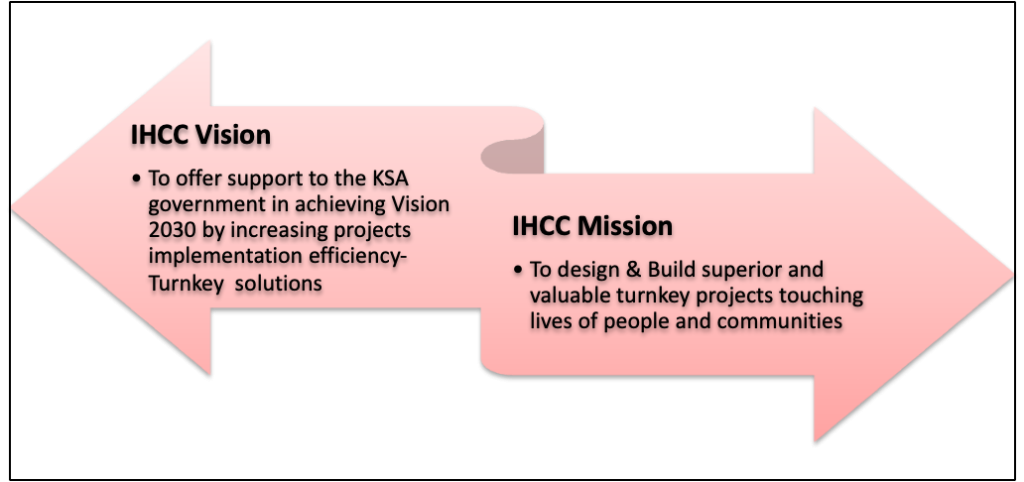Questions
- The fit to organisational strategy and job climate/macro factors (AC 1.2)
- The ability to attract, motivate and retain appropriate employees (AC 1.4)
- Legal and international consideration for pay and reward (AC 3.5, AC 4.1)
- Equity, transparency and fairness considerations (AC 4.3, AC 4.4)
Solution
3.0 Justification of Job Role/Family (1975 Words)
3.1 Fit to organisational strategy and job climate/macro factors
3.1.1 Fitting Organisation Strategy
Organisation strategy is defined in da Cunha (2021) as a process of establishing a roadmap for leveraging
on competitive advantage and market dominance. For example, IHCC strategy is offering turnkey solutions for healthcare, education, and different mixed-use projects. This is also evidenced in the IHCC organisation vision and mission as shown in figure 7;

Figure 7: IHCC Vision and Mission
Hence, for IHCC to achieve the identified strategy as presented in their vision and mission, retention of technical experts and other professionals is essential. IHCC reward approach is hence similar to what Saeed et al. (2019) identify as existence of a link of reward approach with the organisation strategy as evidenced in their vision and mission.
In order to evidence the scope of IHCC rewards link to their organisation strategy, SWOT analysis can be used. According to CIPD (2021a) this is a tool identifying Strengths, Weaknesses, Opportunities and Threats which represent internal and external factors (see table 2);

Table 2: IHCC SWOT Analysis (Link of organisation strategy and rewards)
Through the reference on path-goal model, Olowoselu et al. (2019) noted that productivity is a path contributing to achievement of the organisation strategy hence tend to work hard if appreciated. For instance, as illustrated in table 2, IHCC could capitalise on non-monetary rewards for millennials and generation Z, source more feedback from employees to appreciate improvement areas.
Low productivity on the other hand is as a result of failure to attract the employees to a path of appreciation to meet their goals/strategy. This is since the organisation has not invested in total rewards in their operations. These are represented in SWOT analysis as lacking elaborate metric of performance evaluation, unequal pay offered to senior management teams and administration. It is in this regard that Fatima (2021) publication offered an example of Samsung company which offer their employees with a reward system based on results. Despite of this, their employees are not found complaining on differences obtained from the results of employees efforts on responsibilities and duties. This could be the reason SWOT analysis evidence on performance based pay and total rewards for technical services Job Family as improving their satisfaction.
Similarly, for IHCC, by adopting such an approach, they would have a significant incentive range and rewards which would be core on an technical services Job Family employees total wage. However, with SWOT analysis identified threats of economic recession and low government investment on Turnkey solution projects, IHCC need to diversify their revenues base to improve on their employees reward approach.
Further, PESTLE analysis can be used to identify the factors with significant impact to the organisation approach to rewards. This include;
Political– The appropriate political climate in Saudi Arabia (KSA) offers an opportunity for good pay to be offered to their employees. As such, there are no prevalent conflicts which could affect ability of IHCC to offer their employees with a good pay.
Economic– In Alharbi (2021) report, it argued that a negative implication on the pandemic on GDP in 2020 lowered with 9.8%. This had a negative implication on how rewards are offered to the employees. Also, Reuters (2022) report identified KSA economy inflation to have increased to 2.1%. To provide their employees with an opportunity to cope up with this challenge, IHCC has increased all their employees pay with 4.3%.
Technology– In Trade.GOV (2022) report, the KSA technology market is projected to attain $2.9 billion as at 2025. This is with an annual growth rate of 12.8%. As such, IHCC has introduced development programs and learning sessions for their employees with an intention of increasing their awareness on use of technology and innovation.
Legal– Saudi Arabia operates under the Labour laws (Papayaglobal, 2022). This stipulates on the mandatory deductions (social insurance tax, occupational hazard) and minimum wage which is set at 4,000 SAR Monthly.
3.1.2 Fitting Job Climate/Macro Factors
Please click the icon below to access this assessment in full
